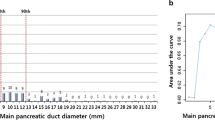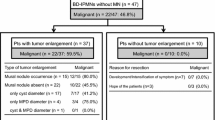Abstract
Background
The majority of branch duct intraductal papillary mucinous neoplasms (BD-IPMNs) are recommended for surveillance imaging based on consensus guidelines. However, growth rates that should prompt concern for malignant transformation of BD-IPMN are unknown.
Aims
To determine whether BD-IPMN growth can predict an increased risk of malignancy and define growth rates concerning for malignant BD-IPMN.
Methods
The study is a retrospective, multicenter study of suspected BD-IPMN patients undergoing imaging surveillance. All patients underwent EUS evaluation followed by surveillance imaging.
Results
Two hundred and eighty-four patients with suspected BD-IPMN without worrisome features or high-risk stigmata were followed for a median 56 months and underwent a median of four imaging studies. Nine patients (3.2 %) developed malignant BD-IPMN. Malignant BD-IPMN grew at a faster rate (18.6 vs. 0.8 mm/year; P = 0.05) compared to benign BD-IPMN. BD-IPMN growth rate between 2 and 5 mm/year was associated with an increased risk of malignancy with hazard ratio (HR) of 11.4 (95 % CI 2.2–58.6) when compared to subjects with BD-IPMN growth rate <2 mm/year (P = 0.004). BD-IPMN growth rate ≥5 mm/year had a hazard ratio of 19.5 (95 % CI 2.4–157.8) (P = 0.005). BD-IPMN growth rate of 2 mm/year had a sensitivity of 78 %, specificity of 90 %, and accuracy of 88 % to identify malignancy. Total BD-IPMN growth was also associated with increased risk of malignancy (P = 0.003) with all malignant IPMNs growing at least 10 mm prior to cancer diagnosis.
Conclusions
BD-IPMN growth rates ≥2 mm/year and total growth of ≥10 mm should be considered worrisome features for BD-IPMN at increased risk of malignancy.

Similar content being viewed by others
References
Tanaka M, Fernández-del Castillo C, Adsay V, et al. International consensus guidelines 2012 for the management of IPMN and MCN of the pancreas. Pancreatology. 2012;12:183–197.
Vege S, Ziring B, Jain R, et al. American gastroenterological association institute guideline on the diagnosis and management of asymptomatic neoplastic pancreatic cysts. Gastroenterology. 2015;148:819–822.
Jang JY, Park T, Lee S. Validation of international consensus guidelines for the resection of branch duct-type intraductal papillary mucinous neoplasms. Br J Surg. 2014;101:686–692.
Kim KW, Park SH, Pyo J, et al. Imaging features to distinguish malignant and benign branch-duct type intraductal papillary mucinous neoplasms of the pancreas; a meta-analysis. Ann Surg. 2014;259:72–81.
Shimizu Y, Yamaue H, Maguchi H, et al. Predictors of malignancy in intraductal papillary mucinous neoplasm of the pancreas: analysis of 310 pancreatic resection patients at multiple high-volume centers. Pancreas. 2013;42:883–888.
Kang MJ, Jang JY, Kim SJ, et al. Cyst growth rate predicts malignancy in patients with branch duct intraductal papillary mucinous neoplasms. Clin Gastroenterol Hepatol. 2011;9:87–93.
Bae SY, Lee KT, Lee JH, Lee JK, Lee KH, Rhee JC. Proper management and follow-up strategy of branch duct intraductal papillary mucinous neoplasms of the pancreas. Dig Liver Dis. 2012;44:257–260.
R Core Team. R: a language and environment for statistical computing. Vienna: R Foundation for Statistical Computing; 2014.
Therneau T (2014) A package for survival analysis in S. R package version 2.37-7.
Yamaguchi T, Baba T, Ishihara T, et al. Long-term follow-up of intraductal papillary mucinous neoplasm of the pancreas with ultrasonography. Clin Gastroenterol Hepatol. 2005;3:1136–1143.
Maimone S, Agrawal D, Pollack MJ, et al. Variability in measurements of pancreatic cyst size among EUS, CT, and magnetic resonance imaging modalities. Gastrointest Endosc. 2010;71:945–950.
Acknowledgments
The study was partially supported by the National Institutes of Health Grant UL1TR000100 (Ronghui Xu).
Conflict of interest
None.
Author information
Authors and Affiliations
Corresponding author
Rights and permissions
About this article
Cite this article
Kwong, W.T., Lawson, R.D., Hunt, G. et al. Rapid Growth Rates of Suspected Pancreatic Cyst Branch Duct Intraductal Papillary Mucinous Neoplasms Predict Malignancy. Dig Dis Sci 60, 2800–2806 (2015). https://doi.org/10.1007/s10620-015-3679-8
Received:
Accepted:
Published:
Issue Date:
DOI: https://doi.org/10.1007/s10620-015-3679-8




